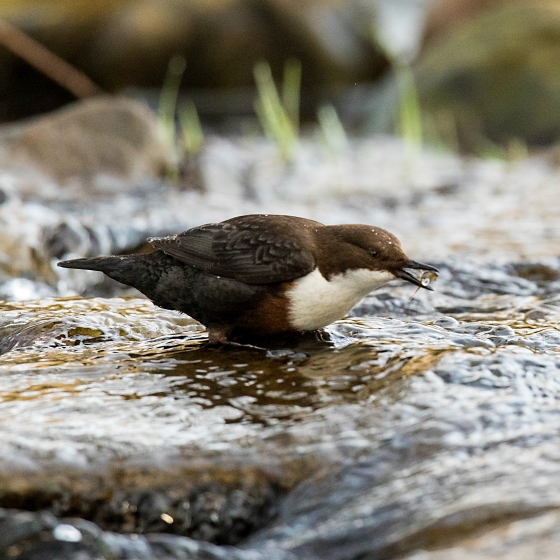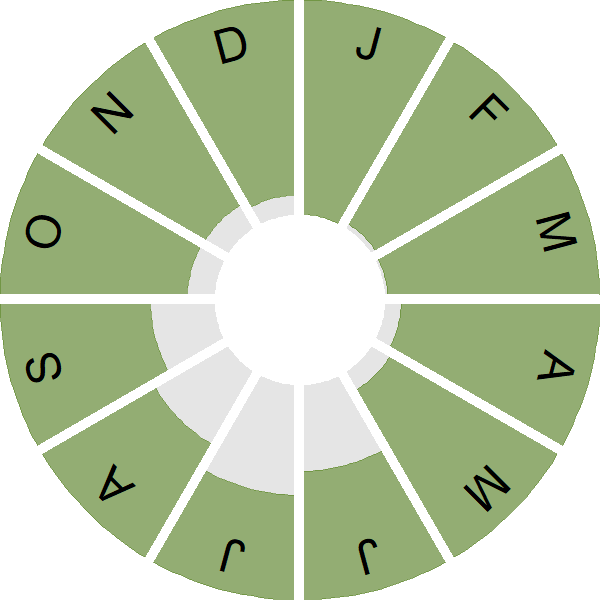Dipper

Introduction
These aquatic birds are unique among British & Irish passerines, foraging underwater for small invertebrates in fast-flowing streams.
Dippers are primarily found year round in northern and western Britain, and much of the island of Ireland. In winter, individuals may be reported further east, but this part of Britain lacks suitable Dipper breeding habitat. Although UK Dipper numbers have fluctuated in recent decades, there is an overall downward trend, and this species is on the UK Amber List.
Adult Dippers are primarily dark brown in appearance, with a white throat and chest. They can often be spotted, tail cocked, standing on a stone in fast, shallow streams, from where they will either walk into the water to hunt their invertebrate prey, or fly low to the surface to another perch, with a rapid wingbeat. Breeding pairs will defend a territory along a stretch of water. Juveniles Dippers have a more mottled, grey appearance.
- Our Trends Explorer gives you the latest insight into how this species' population is changing.

Key Stats
Identification
Songs and Calls
Song:
Begging call:
Status and Trends
Conservation Status
Population Change
The WBS/WBBS shows that Dipper populations have fluctuated over the last thirty years, with a general downward trend. Through its strengthening UK breeding decline, the species was moved from green to being amber listed in the latest review (Eaton et al. 2015).
Distribution
Dippers are exclusively associated with fast-flowing, stony-bottomed watercourses, whether in winter or in the breeding season. They are widespread throughout non-coastal areas in Scotland, Wales, northern and southwestern England, and absent from low-lying areas of central, south and eastern England. Densities tend to be relatively high in Scotland, northern England and the southern half of Wales.
Occupied 10-km squares in UK
or view it on Bird Atlas Mapstore.
or view it on Bird Atlas Mapstore.
European Distribution Map
Distribution Change
Breeding range changes since the 1968–72 Breeding Atlas in Britain have been slight (-11%). Small losses in northern and western Scotland may be related to acidification problems from conifer plantations. Farther south, it is notable that losses have taken place on the eastern fringe of the range in Wales and southwest England.
Change in occupied 10-km squares in the UK
or view it on Bird Atlas Mapstore.
or view it on Bird Atlas Mapstore.
Seasonality
In suitable locations Dipper is recorded throughout the year.
Weekly pattern of occurrence
The graph shows when the species is present in the UK, with taller bars indicating a higher likelihood of encountering the species in appropriate regions and habitats.

Movement
Britain & Ireland movement
Foreign locations of birds ringed or recovered in Britain & Ireland
Dots show the foreign destinations of birds ringed in Britain & Ireland, and the origins of birds ringed overseas that were subsequently recaptured, resighted or found dead in Britain & Ireland. Dot colours indicate the time of year that the species was present at the location.
- Winter (Nov-Feb)
- Spring (Mar-Apr)
- Summer (May-Jul)
- Autumn (Aug-Oct)

European movements
EuroBirdPortal uses birdwatcher's records, such as those logged in BirdTrack to map the flows of birds as they arrive and depart Europe. See maps for this species here.
The Eurasian-African Migration Atlas shows movements of individual birds ringed or recovered in Europe. See maps for this species here.
Biology
Productivity and Nesting
Nesting timing
Egg measurements
Clutch Size
Incubation
Fledging
Survival and Longevity
Survival is shown as the proportion of birds surviving from one year to the next and is derived from bird ringing data. It can also be used to estimate how long birds typically live.
View number ringed each year in the Online Ringing Report.
lifespan
Survival of adults
Biometrics
Wing length and body weights are from live birds (source).
Wing length
Body weight
Ring Size
Classification, names and codes
Classification and Codes
- Order: Passeriformes
- Family: Cinclidae
- Scientific name: Cinclus cinclus
- Authority: Linnaeus, 1758
- BTO 2-letter code: DI
- BTO 5-letter code: DIPPE
- Euring code number: 10500
Alternate species names
- Catalan: merla d'aigua europea
- Czech: skorec vodní
- Danish: Vandstær
- Dutch: Waterspreeuw
- Estonian: vesipapp
- Finnish: koskikara
- French: Cincle plongeur
- Gaelic: Gobha-dubh-an-uisge
- German: Wasseramsel
- Hungarian: vízirigó
- Icelandic: Fossbúi
- Irish: Gabha Dubh
- Italian: Merlo acquaiolo
- Latvian: udensstrazds
- Lithuanian: paprastasis vandeninis strazdas
- Norwegian: Fossekall
- Polish: pluszcz (zwyczajny)
- Portuguese: melro-d'água
- Slovak: vodnár potocný
- Slovenian: povodni kos
- Spanish: Mirlo acuático europeo
- Swedish: strömstare
- Welsh: Bronwen y Dwr
- English folkname(s): Water Ousel
Research
Causes of Change and Solutions
Causes of change
The drivers of change for Dipper are unclear; however breeding productivity has risen so it is unlikely that problems during the nesting stage have contributed to the observed declines.
Further information on causes of change
The species is unusually sensitive to acidity and other water-borne pollution (Ormerod & Tyler 1989, 1990), with lower breeding densities and productivity on acidic than on more neutral streams (Ormerod et al. 1991, Vickery 1991, 1992). Breeding performance has improved strongly over time, and laying dates have shifted earlier, perhaps because of climate change (Crick & Sparks 1999). Broods now average larger than in the late 1960s and 1970s, and there has been substantial reduction in failure rates of nests at the egg stage, leading to sustained increase in the number of fledglings per breeding attempt. In a river system in southern Norway, climate variables including winter temperature explained 84% of the variation in population level during 1978-2008 (Nilsson et al. 2011). Thus, some of the UK fluctuations may relate to winter weather.
Information about conservation actions
The drivers of change are unclear, but are unlikely to be due to problems during the breeding season and fluctuations in abundance could relate mainly to winter weather. However, Dippers are sensitive to acidity (see Causes of Change section, above) and therefore conservation actions which protect rivers from pollution and which ensure they do not become more acidic are likely to help to ensure that conditions remain optimal for Dippers.

